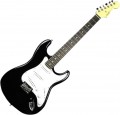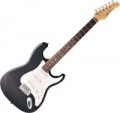Material
The material from which the body of an electric guitar is made. For models with cutouts (semi-acoustic, see "Type"), in this case, only the material of the back deck and sides can be taken into account, and data on the top deck is given separately (for more details, see "Deck Cover Material").
Now on the market there are cases of such trees:
red,
maple,
agatis,
ash,
alder.
It makes no sense to dwell on each of the materials found in modern electric guitars. Their variety is very large, however, unlike acoustic guitars, the body in this case does not play such a significant role in shaping the sound, and its material has a relatively small effect on the acoustic properties of the instrument (although the exact degree of such influence is a moot point). If you wish, you can find detailed data on a particular material in special sources, but in fact it makes sense to look primarily at the appearance of the instrument and its price category.
Bridge
The type of bridge provided in the construction of the guitar.
The bridge is often referred to as the part used to secure the strings to the body, but this is not entirely true. There are many models where the bridge plays only the role of a nut (limits the length of the scale), and the string is fixed in a separate device (stop bar) or even in the guitar body, through the method (see below).
All modern breeches can be divided into two main categories. The first is
fixed, in which the strings are fixed, and the tightening during the game can only be performed with the left hand on the fretboard. They somewhat limit the set of techniques available to the musician, but they are inexpensive, compact and do not complicate the tuning of the guitar. The second variety is
tremolo("machines"), which have a lever under the guitarist's right hand, allow you to change the tension of all the strings at once and achieve interesting effects that are not available with a conventional tightening. The disadvantages of "machines" are the opposite of the advantages of "fixes": tremolo bridges are more expensive, often cumbersome, with frequent use they can quickly detun the instrument, and tuning is often quite difficult, requiring specific skills and tools. Note that tremolo machines are used only in electric and semi-acoustic guitars, bass guitars are equipped only with fixed tailpieces.
The main
...types of bridges found in modern electric guitars are as follows:
— Fixed. This designation is used for all fixed breeches other than the popular varieties described below.
— Hardtail (fixed). A distinctive feature of "hardtails" is a metal plate that plays the role of the basis for other mechanics. Such a plate is installed on the top deck; it is bent up from the far side (from the fretboard), and the saddles for the strings are attached simultaneously to the base and to the bent part. The fastening of the strings is often done through. This type of bridge allows you to individually adjust for each string not only the length of the scale, but also the height above the fretboard.
— Tune-o-Matic (fixed). Bridge in the form of a plank, on which saddles for strings are fixed. In this case, the strings can be attached to the body of the guitar (through method), to a separate stop bar or in the holes on the bridge itself (however, the latter is rare). Tune-o-Matic allows you to individually adjust the scale for each string, however, the height above the neck is changed only by changing the height and inclination of the bar (for this, an adjustment screw is provided at each end of the bar).
— Tremolo. Tremolo machines that do not belong to any of the varieties described below; this option is also indicated in cases where the manufacturer, for some reason, did not specify the specific type of "car". This category includes mechanisms that are quite diverse in design and functionality, so the features of such a bridge in each case should be specified separately.
— Vintage Tremolo. One of the first varieties of tremolo machines, developed by Fender. Externally, such a device looks like the Hardtail described above, supplemented by a movable (swivel) mount and a lever for adjusting the tension; fastening strings — most often through. Keep in mind that Vintage Tremolo's are designed primarily for downtuning; it is possible to raise the system with the help of such a machine only slightly, and then this will require certain tricks. Another drawback is that heavy use of the tremolo arm detunes the guitar quite quickly — especially if the player has neglected the tuning rules, which, although not difficult for Vintage Tremolo, are quite specific. On the other hand, “vintages” are inexpensive, and you can compensate for the mentioned drawback, for example, by using a top lock. The classic "vintage" is attached to the body with six screws, but there are also twin-screw versions — they are simpler and at the same time keep the system longer with active use.
— Wilkinson (tremolo). A further development of the design of the Vintage Tremolo described above. One of the key differences of the "Wilkinson" is that the strings in it are held on the bridge itself, and not on the body of the guitar. Because of this, this type of breeches stay in tune much better than the original "vintage" breeches. In addition, the lever in such "machines" is attached without thread, so that the likelihood of backlash is reduced to zero. On the other hand, Wilkinson bridges are noticeably more expensive, and their main function is to lower the tuning (although, again, with some tricks, a slight increase is possible).
— Bigsby (tremolo). Another representative of the "timeless classic", perhaps the first tremolo system in the world. Today it is used mainly on vintage-style guitars; particularly well suited for semi-acoustic instruments, as attached to the end of the guitar, not to the thin top, and does not place heavy loads on the soundboard. A distinctive feature of the Bigsby is that as a stop bar to which the strings are attached, such machines use a round rod that rotates from the movement of the lever and thus changes the tension of the strings. Due to this, such bridges have a number of advantages: they can work both down and up, they are easy to tune and keep the system well and respond to the slightest movement of the lever, allowing the musician to control the sound very precisely. In addition, Bigsby systems have a stylish appearance. On the other hand, they are quite massive and bulky, expensive, and the adjustment range is relatively small (smaller than that of the same Floyd Rose).
— Floyd Rose (tremolo). One of the most popular tremolo systems used by professional musicians. It is similar in design to the Vintage Tremolo, in particular, it is also mounted on two bolts and has a spring that compensates for the tension of the strings. However, the design of the Floyd Rose allows the action to be changed both downwards and upwards (increasing the tension), providing possibilities that are not available with "vintage" and similar systems; and similar machines differ from Bigsby in a wider range of adjustment. Note that the design of instruments with such bridges usually includes a top-lock — a device that clamps the strings on the fingerboard at the nut. Thanks to this, the “floyd roses” perfectly keep the system when actively working with the lever. All this led to the popularity of these systems among guitarists. On the other hand, setting up and caring for such breeches is a very difficult, painstaking and delicate matter. So, for setting strings and tuning, a whole set of keys may be required; when a string breaks, the system “floats”, and replacing a damaged string is inevitably associated with retuning the entire guitar; moreover, the system can go astray even from inaccurate movement of the instrument or a strong blow with the palm when muting the strings. Therefore, Floyd Rose type machines are mainly recommended for advanced guitarists with experience in handling electric guitars. And even professional musicians sometimes prefer to go to the master, rather than messing around with the service themselves.
— Kahler (tremolo). A system similar to Floyd Rose, but without springs and fixed directly to the body, usually with 4 screws. This allows you to slightly increase the sustain (due to improved contact of the strings with the body). The rest of the advantages and disadvantages are in most cases the same as Floyd Rose. However, high-quality solutions are also produced under the Kahler brand, which are not cheap, but have an improved design and are devoid of a number of disadvantages — in particular, such models are insensitive to changes in the position of the instrument and sharp muting of the strings with the palm of your hand.
— Zero Resistance (tremolo). Another improved version of the Floyd Rose described above, which is distinguished by the presence of a blocker — a device that rigidly fixes the bridge. Thanks to this, the system does not “float” when the string breaks, and the tuning of the guitar is noticeably simplified compared to the original Floyd Rose. The disadvantage of ZR is traditional — a high price.
It is worth noting that the above list does not include specific brands of bridges, but only their general types; within the same type, there may be models that differ somewhat in design and functionality.Number of frets
The fret is the gap between the nut on the fretboard; each such interval is responsible for its own note (the interval between the frets is half a tone). Accordingly, the more frets, the more notes you can play on one string. However, keep in mind that the width of the gaps between the nut decreases as you get closer to the bridge, and if there are a lot of frets, playing at high frets can be difficult, requiring very high accuracy.
The most popular options today are
22 or
24 frets, they are found in most electric guitars of all types. In basses, there are also a smaller number (
20 frets and
21 frets), because. the distance between the nut on such instruments is greater, and the necks, respectively, with the same number of frets, are longer than those of guitars.
In general, paying attention to this parameter makes sense, first of all, for professional musicians, for whom a vast “space for manoeuvre” is fundamentally important.
A separate category is
fretless instruments, completely devoid of nut. Almost all of them relate to bass guitars; there are also electric guitars without frets, but very rarely. In such instruments, the role of the nut is played by the musician's finger, which presses the string to the fretboard. The technique of playing fretless guitars is noticeably mor
...e complicated: firstly, to extract clean notes, you need a very precise position of the finger; secondly, this design reduces the volume of the sound and the duration of the sustain, and special playing techniques may be required to obtain the sound of the desired volume (and heavier strings for basses). On the other hand, the lack of frets gives the professional musician a number of additional options. For example, on a fretless neck, you can make very smooth slides, without stepping between notes, and the instrument itself is not tied to a standard 12-step scale, which can be very useful in some areas of music (experimental, oriental, etc.). Also note that the fretless bass guitar, both in sound and playing technique, is very close to the classical double bass, which is especially appreciated by lovers of jazz and other similar styles.
